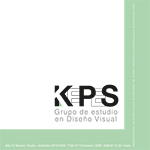Authors
Abstract
The results of a research conducted during the 2016-2017 period in the School of Architecture, Urban Planning and Design at Universidad Nacional de San Juan are presented in this article. This work aimed to analyze the Graphic Design conceptions students have when choosing this program as a career and its coherence with the current study plan versus design and technology. This is a nonexperimental descriptive research in which qualitative and quantitative methods have been jointly applied. The study population consisted of 336 students who attended the common Entrance Course to start a career in the School of Architecture, Urban Planning and Design in the 2017 cycle. Two intentional non-probability samples were studied, formed by students attending the Entrance Course who, at the beginning and at the end of the course, confirmed to be convinced of choosing the Graphic Design career. In order to identify the conceptions, the Social Representation theory and its structural approach were used. To obtain the data, both associative and interrogative methods were used. For the students interviewed at the beginning of the Entrance Course, Graphic Design constitutes a rather artisan activity closely related to expression through drawing but fairly related to communication. For the students interviewed at the end of the course, the career is an activity oriented towards communication but closely connected with artistic expression. Both at the beginning and at the end of the Entrance ourse, students conceived Graphic Design as a discipline completely different from a technological discipline. This revealed a conception of Graphic Design discrepant with the curricular proposal of the institution.
Keywords:
References
Abric, J. (2001). A structural Approach to Social Representations. En K. Deaux and G. Philogène, Representations of the Social (pp. 42-47). New York, USA: Blackwell Publishers.
Aparicio, M. y Mazzitelli, C. (2008). Comparación de la estructura de las representaciones sociales de docentes y alumnos sobre las ciencias (parte I). Revista de Orientación Educacional, 22 (40), 13-29.
Aparicio, M. y Mazzitelli, C. (2008). Comparación de la estructura de las representaciones sociales de docentes y alumnos sobre las ciencias (parte II). Revista de Orientación Educacional, 22 (41), 15-29.
Arfuch, L. (1997). El diseño en la trama de la cultura: desafíos contemporáneos. En L. Arfuch, N. Chaves y M. Ledesma (Comp.), Diseño y comunicación: teorías y enfoques críticos (pp. 137-223). Buenos Aires, Argentina: Paidós.
Buchanan, R. (1992). Los problemas malditos del pensamiento de diseño. Recuperado de https://issuu.com/imdi.cmd/docs/los_problemas_malditos_del_pensamie.
Caro, S. (2013). La función de la estética y la estética de la función. El diseño más allá de lo lindo y lo feo. En M. Cuervo y M. Massafra (Coord.), Escritos en la Facultad (pp. 31-37). Buenos Aires, Argentina: Universidad de Palermo.
Chaves, N. (2004). El diseño: ni arte ni parte. En A. Calavera, Arte ¿? Diseño (pp. 118-138). Barcelona, España: Gustavo Gili.
Consejo Superior de la UNSJ. (2015). Ordenanza Nº022/15/CS. Recuperado de http://www.digesto.unsj.edu.ar/admin/digesto_admin/pdf/ORD22O-1511761.pdf.
Costa, J. (2005). La eterna e inútil discusión. FOROALFA. Recuperado de http://foroalfa.org/articulos/la-eterna-e-inutil-discusion.
Farr, R. (1986). Las representaciones sociales. En S. Moscovici (Comp.), Psicología social. Barcelona, España: Paidós.
Feenberg, A. (1991). Critical Theory of Technology. Oxford, England: Oxford University Press.
Feenberg, A. (1999). Questioning Technology. New York, USA: Routledge.
Feenberg, A. (2000). El parlamento de las cosas. Critical Theory of Technology. Oxford, England: Oxford University Press.
Feenberg, A. (2005). Teoría crítica de la tecnología. CTS. Revista Iberoamericana de Ciencia, Tecnología y Sociedad, 2 (5), 109-123.
Fourez, G. (2005). Alfabetización científica y tecnológica. Buenos Aires, Argentina: Colihue.
Gay, A. (2008). La tecnología como disciplina actual. Recuperado de http://www.unsj.edu.ar/unsjVirtual/comunicacion/seminarionuevastecnologias/wp-content/uploads/2017/04/Aquiles_Gay.pdf.
González Solas, J. (2007). ¿Arte, estética o ideología? FOROALFA. Recuperado de http://foroalfa.org/articulos/la-eterna-e-inutil-discusion.
Giuliano, G. (2008). Tecnología, desarrollo y democracia: hacia otra artificialidad posible. Scientiæ Studia, 6 (3), 371-377.
Giuliano, G. (2007). Interrogar la tecnología. Buenos Aires, Argentina: NuevaLibrería.
Jodelet, D. (1986). La representación social: fenómenos, concepto y teoría. En S. Moscovici (Comp.), Psicología social. Barcelona, España: Paidós.
Ledesma, M. (1997). Diseño gráfico, ¿un orden necesario? En L. Arfuch, N. Chaves y M. Ledesma (Comp.), Diseño y comunicación: teorías y enfoques críticos. Buenos Aires, Argentina: Paidós.
Petracci, M. y Kornblit, A. (2007). Representaciones sociales una teoría metodológicamente pluralista. En A. Kornblit (Coord.), Metodologías cualitativas en ciencias sociales. Buenos Aires,
Argentina: Biblos.
Moscovici, S. (1979). El psicoanálisis, su imagen y su público. Buenos Aires, Argentina: Editorial Huemul.
Wachelke, J. (2008). Relationship between response evocation rank in social representation associative tasks and personal symbolic value. International Review of Social Psychology, 21 (3), 113-126.

 pdf (Español (España))
pdf (Español (España))
 FLIP
FLIP
 Perfil Google Scholar
Perfil Google Scholar


















